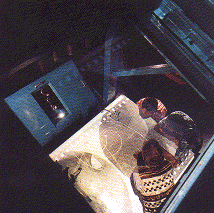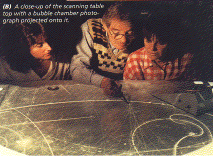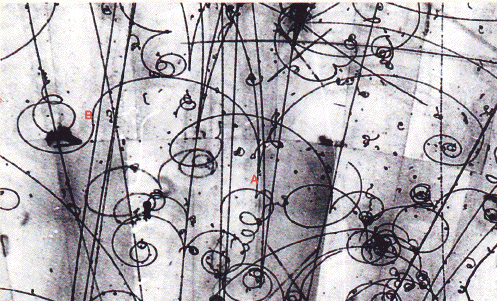 |
High School
Teachers at CERN |
 |
|
| WWW.CERN.CH |  |
||
The following article first appeared in Catalyst, a UK Science journal published for GCSE (up to 16 years old). We are grateful that this material is available to us. A lot can happen in......a few billionths of a second.Goronwy Tudor Jones (University of Birmingham). You will know that atoms consist of a cloud of electrons, surrounding a tiny nucleus made of nucleons (protons and neutrons). Here Goronwy Tudor Jones, a particle physicist, gives an insight into how the substructure of nucleons is studied.Particle physicists study the basic building blocks of nature and the forces they exert upon each other. The key idea behind many of their experiments is very simple. If you want to know what is inside an object, shoot into it something you know and measure what comes out. In particle physics we are interested in finding out what protons and neutrons (nucleons) are made of. We investigate this by shooting beams of known particles at nucleons from a machine called an accelerator. What comes out of this collision is measured in a detector. An accelerator at the European Laboratory for Particle Physics (CERN) straddles the French/Swiss border near Geneva. The way it works is described on another page. Recently there was a conference at CERN to celebrate the results obtained from a spectacular detector called the bubble chamber. This makes use of the fact that, when a charged particle travels through a specially prepared liquid, such as superheated liquid hydrogen, a trail of bubbles is formed along its path. The bubble trail can be photographed to give a permanent record of the particle's path - a bit like the vapour trail of an aeroplane. Particle physicists measure and analyse photographs of what comes out of individual collisions between beam particles and nucleons. ANALYSlNG BUBBLE CHAMBER PHOTOGRAPHS Until very recently, the School of Physics and Astronomy at the
University of Birmingham was involved, with several other institutions around the world,
in analysing millions of bubble chamber photographs, taken at international accelerator
laboratories like Fermilab in Chicago and CERN. In a barn-like darkened room containing a
dozen 'scanning tables', pictures were inspected carefully by 'scanners' (trained
non-physicists) for features considered especially important to particle physicists.
Here we are looking at a spray of tracks coming from a
collision between a neutrino (which itself leaves no tracks because it is neutral) and a
nucleon. To get a feel for how we interpret such pictures, you should turn a printout
upside down and look at it from a very low angle -- we often have our chins on the table!
We would also have two or three other views of the same 'event' to help in the
interpretation. The actual tracks in the bubble chamber would be two or three times longer
than the projection on the table. The charged particle trails curve because the bubble chamber is inside a strong magnet. Negative particles such as electrons curve in one direction as they travel, positive particles curve the other way. The more curved the track is, the slower the particle is moving (strictly speaking, the lower its momentum). A little later an exceptional example of a bubble chamber photograph is discussed in detail. It includes a very rare side-show - a head-on collision between an anti-electron (a positron, e+) and a 'stationary' electron (e-). Nowadays, bubble chambers are being replaced by electronic detectors, such as those in the LEP detectors. Beams of anti-electrons and electrons are fired towards each other and the screens, and the information about collisions is recorded on computer rather than on film. A
REMARKABLE CHANCE
|
| © CERN and High School Teachers Programme at CERN | Last modified: 28 June 2002 |


